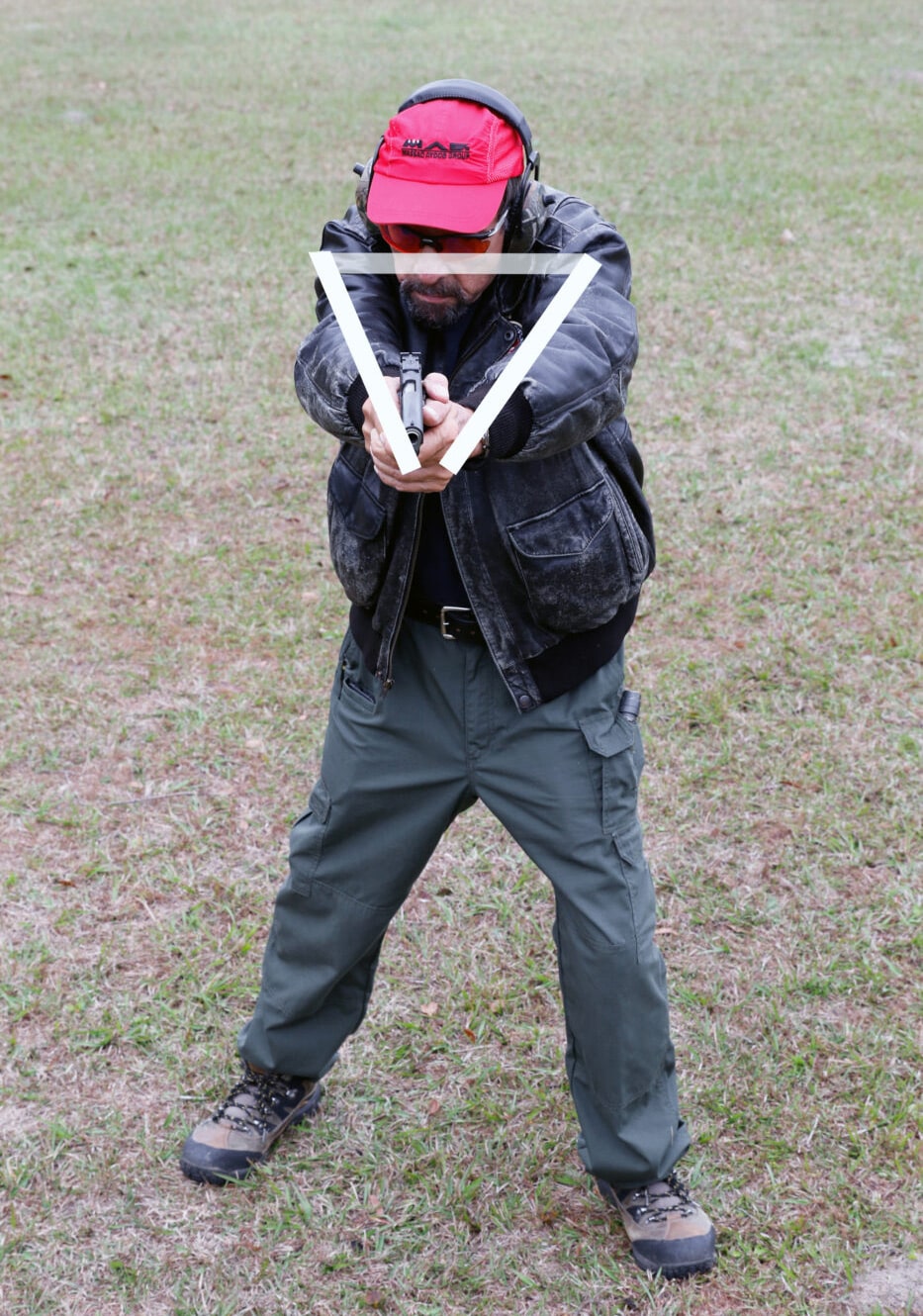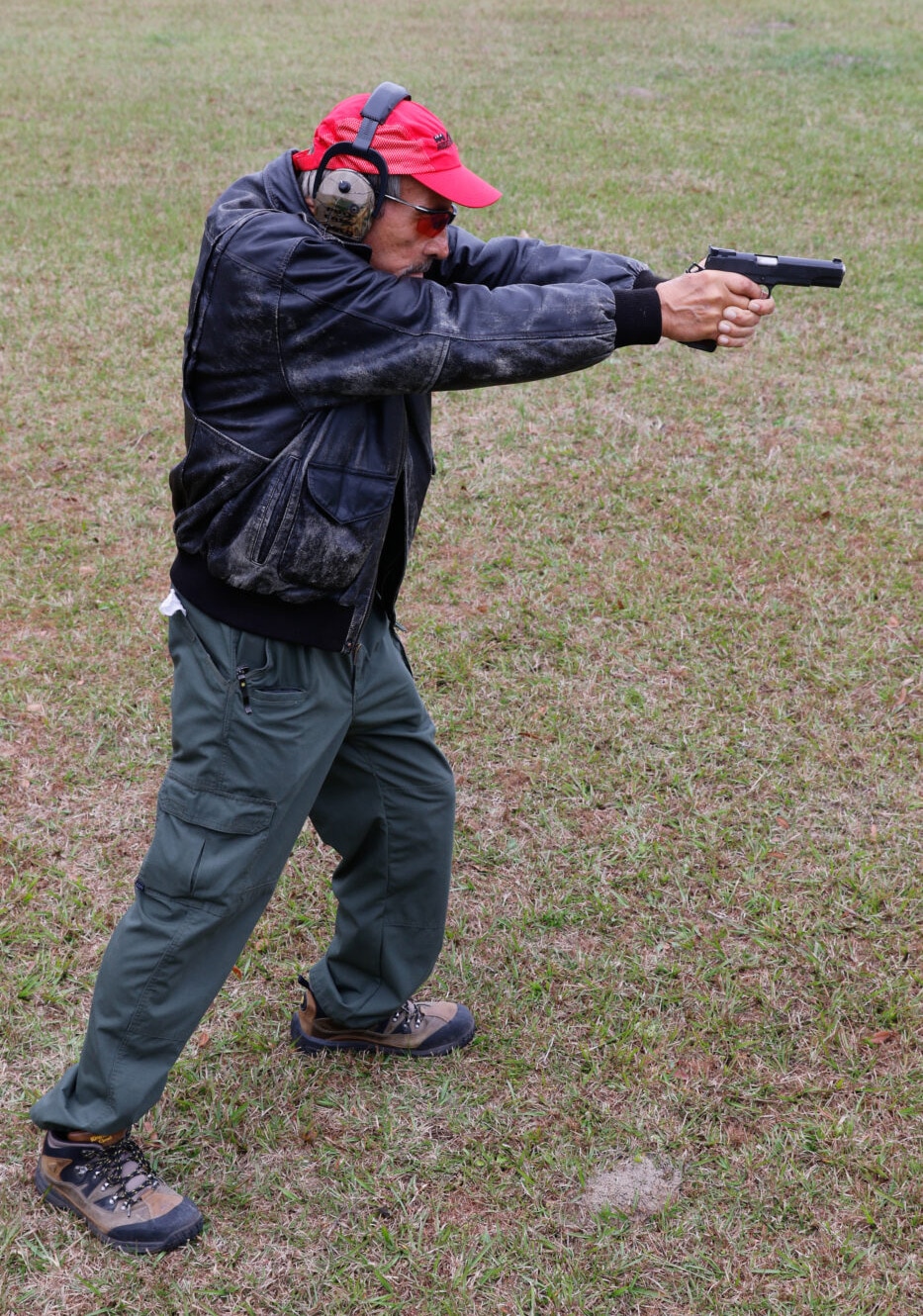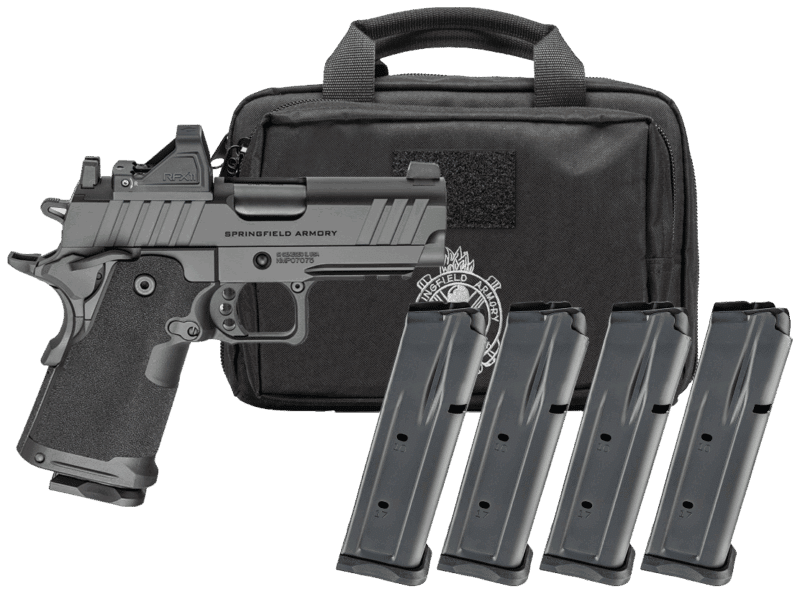Ayoob: Shooting the Isosceles Stance
March 13th, 2022
8 minute read
Editor’s Note: This article on shooting a pistol using the Isosceles Stance is the last in a four-part series by Massad Ayoob on the major two-handed shooting stances. You can find the overview of shooting stances here, part two on the Classic Weaver Shooting Stance here and part three on the Modified Weaver Stance here.

Today, the most popular two-handed shooting stance — from police and military ranges to competition firing lines to YouTube — is the Isosceles. The term derives from basic geometry: in this stance, both arms extend straight out from the shoulders forming an Isosceles triangle, vis-à-vis the chest.
A Brief History of the Isosceles Shooting Stance
The Isosceles Stance is old. Going back to second-quarter 20th century, W. E. Fairbairn suggested it for long shots or precision shots in his classic book “Shooting to Live,” and Bill Jordan demonstrated something similar for the same purposes in his 1966 classic “No Second Place Winner.” (It should be noted, though, that both of those authorities recommended one-hand-only for fast, close reaction shooting.) Jeff Cooper, the foremost proponent of the bent-arms Classic Weaver stance, was known to describe the Isosceles Stance in general as the “Fairbairn Isosceles.”

One of Cooper’s own colleagues, Elden Carl, won a series of Cooper’s seminal Leatherslap matches using the Isosceles Stance. Shortly before he died last year, Elden described it to me as both arms locked straight out, and chest square to the target.
Fast forward: In the 1980s, LAPD’s John Pride used an identical stance to win a series of Bianchi Cup matches, known back then as “the Wimbledon of handgun shooting.” In his audio self-help tape for shooters, John at one point said, “Your arms lock out like iron bars … .”

In the early days of IPSC, “if you didn’t shoot some sort of Weaver, you weren’t crap.” The men who changed that in the early and mid-1980s in that game were Rob Leatham and Brian Enos. Training intensively together, they were beating all comers. By the turn of the 21st century, Isosceles was the winning stance in action handgun competitions and was becoming the dominant stance in police and military training as well.
Variations…and Semantics
For many years — hell, for decades — the Isosceles was taught and used poorly.
It was as if someone decided that if one Isosceles triangle was good, two must be better, so they stood with their feet square (i.e., the toes of both feet on the same strip of firing line) and then extended their arms.

This caused the body weight to tip forward, so to counter, shooters were told to S-curve their spines and lean their shoulders back to balance. This worked for slow fire, but with anything more powerful than mouse-fart .38 wadcutters, recoil would rock the shooter back on their heels.
If this had been indeed the only Isosceles interpretation, I would have agreed with Jeff Cooper, the leading proponent of the bent-arms Weaver stance, when he said, “The Isosceles Stance is not merely an alternative lifestyle, it is in fact a perversion.”
Executed effectively, however, the Isosceles is one of the strongest shooting stances. To achieve this effectiveness, simply lose the bottom triangle and put the feet in a boxer’s stance, with the feet at least shoulder-width apart (and preferably more, to compensate for the greater forward extension of the arms, with one foot forward of the other). Make sure head and shoulders are forward of hips, with at least 60% of body weight on a flexed forward leg. The feet are in the boxer’s stance or a martial artist’s front stance, but the shooter wants to pivot the hips and square the chest with the target.
Even today, Isosceles is interpreted differently, and terminology adds to the confusion. Many shooters prefer to bend their elbows slightly, a stance some call “Modern Isosceles.” This can certainly work, but “Isosceles” is a poor term for it. It takes two locked arms to form a true isosceles triangle based at the chest; with bent elbows we have five lines (one chest, two forearms, two upper arms) which are forming a pentagon, not any sort of triangle let alone an Isosceles.
Some bend their elbows slightly down, others turn the knob of the elbows outward. This latter posture allows the hands to press more tightly together laterally on the gun. However, it also tilts the skeleton-muscular support line of the arms outward, bending the wrists slightly, and can create a pivot point at the wrists that allows a hard-kicking handgun’s muzzle to rise more. This interpretation of isosceles seems to work best with guns of 9mm power level and down, or with recoil compensators.
The Isosceles variation that works best for this writer and his students is one I learned from Don Mara in the 1960s. Don was a state champion bullseye shooter and a combat Marine in Vietnam who had killed his share of enemy soldiers with his issue 1911-A1 .45 in close-quarter combat. Don Mara stood with chest square, arms locked out rigid at centerline, and head and shoulders forward. Seen from the right side, his legs and torso took the shape of an Italicized lowercase letter “h”, and with arms and pistol extended, that turned into a “K” configuration with the upper limb of the “K” pointed straight at the target.
Perks and Quirks
As always, every technique has strong and weak points. “Iso” advantages include:
Perhaps the simplest to teach: Face the target in a true fighter’s stance. Extend both arms forward with the handgun until the elbows lock. Keep body weight forward. That’s basically it.
Perhaps the most “instinctive”: When Dr. Walter Cannon at Harvard Medical School defined fight or flight response in the human well over a century ago, he said that the body would “quarter” (read: boxer’s stance), the head and shoulders would come forward, and the torso and head would turn to directly square up with the threat. Put gun in hand, extend arms, et voila: “fight or flight” equals “Isosceles.”

Maximizes body armor protection: That “square the torso to the target” effect puts maximum square inches of body armor protection directly between the wearer and the identified threat’s line of fire. You will recall from the previous chapter that Ray Chapman, who developed the most popular and most successful Modified Weaver stance, recommended Isosceles to armored personnel for just this reason.
Gives maximum range of movement toward the dominant hand side if the shooter is unable to move his or her feet: This is particularly important for the wheelchair-bound, or anyone seat-belted into an automobile who suddenly needs to shoot in self-defense with no time to unbuckle and change position.

Offers, for many, the ideal cross-dominant shooting position: In the previous chapters on the Classic Weaver stance of Jack Weaver and Jeff Cooper and the modified Weaver stance of Ray Chapman, we talked about adaptation for the shooter who is right-handed with a left master eye, or vice-versa. With the Isosceles, less adaptation is required. This is because with the head and body centered on the target, the gun comes more or less to the centerline of the head, making it relatively easy for either eye to acquire a sight picture quickly.
Not dependent on one particular foot being forward: This is important for shooters temporarily or permanently handicapped with a bad knee or ankle. It also allows any shooter to widen their traverse on multiple or moving targets, the more so if they can take a step while doing so.
Isosceles Stance Downsides
Of course, the “Iso” also has its weaknesses, which include:
Sub-optimal for shooting toward the shooter’s non-gun hand side if the feet can’t be moved: A right-handed shooter who starts facing to 12 o’clock will not be able to maintain the two locked arms much past 9 o’clock. Here, the Chapman stance and particularly the Classic Weaver come into their own, just as the Isosceles is the bet choice for that same shooter if he or she must fire to the 3 o’clock angle and cannot move their feet.

Sub-optimal for people with bad elbows: Injury or something like bursitis or arthritis can make it painful, even excruciating to shoot with the gun arm elbow locked straight out. The bent, forward-tensioned arm of the Classic Weaver comes into its own in this situation.
Has caused issues of elbow injury, some have reported: I know one prominent trainer who feels he injured his elbows with constant locked-elbows Isosceles shooting with service pistol cartridges, and knew a gunsmith who suffered an elbow injury shooting a Remington XP-100 pistol chambered for the .458 Winchester Magnum rifle cartridge, literally an “elephant gun” round fired from a handgun, with his arm extended and locked. This varies, of course, among individuals. This writer shoots .44 Magnum and down with locked elbows, bending and tensioning them for things like the .454 Casull, .460 and .500 Magnum, or the .45/70 derringer. Despite chronic and sometimes acute arthritis elsewhere in the body, this writer has experienced no elbow issues whatever.
Sub-optimal for the person who cannot get shoulders or upper body weight forward: With the shoulders back — the paraplegic paralyzed from the chest down being the classic example — a locked gun arm becomes a lever working on the fulcrum of the shoulder, resulting in exaggerated muzzle rise upon recoil.
May not be ideal for shooting “on the move.” As the body bounces, so does anything extended at arm’s length, and the farther the extension the greater the bounce. For that reason, this writer prefers Classic Weaver for shooting while moving: less bounce arc, and the “shock absorber effect” of the isometrically tensioned arms that helps in recoil recovery can also help somewhat in reducing gun bounce while rapidly stepping and shooting.
Summary
There are good reasons to know multiple stances. What works for the instructor may not work for each of his or her students, and what works best for each of us when we get to start “addressed to the target” may not work when we have to adapt to a sudden attack from a flank in a situation where we can’t step into our desired position.
It is respectfully submitted that the discussion shouldn’t be “Weaver or Isosceles,” but rather, “Weaver and Isosceles,” with the Chapman stance a bridge between the two. A shooter conversant and competent with all three is well prepared whether the situation requires the isometric tension of the Classic Weaver, the skeletal support of the Isosceles, or the middle ground of the Chapman stance with locked skeletal support in the gun arm and dynamic if not isometric tension from the support arm.
Editor’s Note: Please be sure to check out The Armory Life Forum, where you can comment about our daily articles, as well as just talk guns and gear. Click the “Go To Forum Thread” link below to jump in!
Join the Discussion
Continue Reading
Did you enjoy this article?

 93
93






